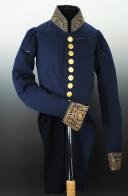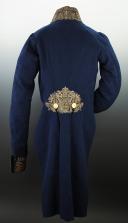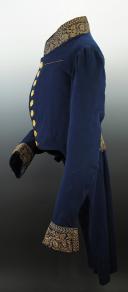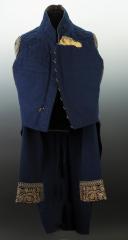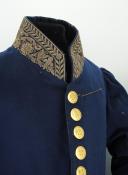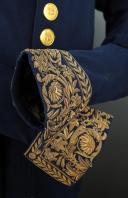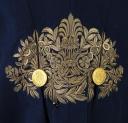
HABIT FRAC OF SMALL UNIFORM OF CHAMBELLAN OF THE CROWN, Restoration (1814-1830). 27590/2952
Sold out
HABIT FRAC OF SMALL UNIFORM OF CHAMBELLAN OF THE CROWN, Restoration (1814-1830). 27590/2952
Tailcoat in slightly dark blue cloth closing straight in front with nine large module buttons in gilded brass stamped with the chamberlains' key surrounded by two fleurs-de-lys and topped with the Royal crown, the edge is framed by two laurel branches.
The tailcoat coat is embroidered with threads, cannetilles and golden sequins representing branches of scabious leaves on the collar, the facings, and at the bottom of the back at the waist knot. On the collar a fleur-de-lys is embroidered on each side.
The facings close with small brass buttons. At the back, two uniform buttons (large module) are sewn at the bottom of the back.
Lining in uniform cloth and black silk.
France.
Restoration (1814-1830).
Good condition, slight oxidation of the trimmings, a few moth holes, a tear inside the lining.
Note: Before the creation of the office of grand chamberlain of France, there existed chamberlains of the king such as Jean de Gaillonet, knight who married Marguerite de Meudon.
Creation of the office of Grand Chamberlain of France.
The office was very old, if we consider that it was a sort of fusion between that of chamberlain proper, and that of chamberlain, abolished by François I in October 1545. The grand chamberlain of France held its importance from the fact that he had permanent access to the king's chamber, a prerogative symbolized by the golden key which he carried at his side, and which became the heraldic badge of dignity of the great chamberlains: they carried two golden keys, with rings finished with a royal crown, in saltire behind their personal arms4,5.
His primary role was management of the king's bedroom and wardrobe. This office provided very close proximity to the royal person and was entrusted to advisors close to the sovereign. Thus, under the reign of Louis
The grand chamberlain signed the charters and important documents, and attended with the king the judgment of the peers. He had custody of the secret seal and the cabinet stamp, received the homage paid to the Crown, and administered the oaths of loyalty in the presence of the King. Its essential function was its role during the coronation.
On the day of the Coronation, he was responsible for receiving the peers in the King's bedroom: the ecclesiastical peers knocked on the closed door, the grand chamberlain asked them what they were looking for, and the peers replied that they were looking for the king. The grand chamberlain then opened the door. During the coronation mass, the grand chamberlain received the royal boots given to him by the abbot of Saint-Denis, and put them on for the king. In the same way, he gave the king the dalmatic and the royal mantle. In all ceremonies, he had precedence as grand officer of the Crown. Bearer of the banner of France, he had rank between the grand master of France and the grand squire. In the beds of justice he sat at the feet of the king.
In the first half of the 16th century, the office was always carried by a member of the house of Orléans-Longueville, then until 1664 by the house of Guise and finally by that of La Tour d'Auvergne, Duke of Bouillon , until the end of the monarchy.
The provost of Paris took the title of ordinary chamberlain of the king because he had access to the sovereign at all times.
Napoleon I attached to his house a grand chamberlain (Talleyrand), as well as ordinary chamberlains. The Restoration retained the title of grand chamberlain until the July Revolution. Napoleon Maret, Duke of Bassano, was created grand chamberlain by Napoleon III.
Under the Restoration the Royal House was put back on its old footing, and there were then, in addition to the grand chamberlain (Prince de Talleyrand), four first gentlemen of the chamber, four masters of the wardrobe, and thirty- two honorary gentlemen of the chamber.
Since the reign of Louis XIII, the first Gentlemen of the King's Chamber have been four in number. They serve one year out of four. The office was instituted by François I who in October 1545 abolished that of chamberlain of France.
The first gentlemen give the shirt to the king, in the absence of the sons of France, princes of the blood, legitimized princes, or of the grand chamberlain3. They are the organizers of the expenses of the king's chamber. A regulation of January 8, 1717 provides that it is by order of the first gentleman in service that the ornaments, hangings, decorations and lighting are provided for the royal houses, the churches of Saint-Denis and Notre-Dame during funeral services. kings, queens, sons, daughters, grandsons and granddaughters of France. They receive the oaths of loyalty from all the officers of the chamber, give them the certificates of service: they give the order to the bailiff, in relation to the people he must let in. Article XXXVIII of the decision of the King's Council of State of June 18, 1757 submits to the first gentlemen the administration and internal discipline of French actors and Italian actors.
The Grand Chamberlain of France under the Second Restoration (1815-1830) Charles-Maurice de Talleyrand-Périgord, Prince of Bénévent, Louis XVIII performed the office.
Tallerand's tunic and court coat are on display at the Château de Valencay: http://ailonuage.canalblog.com
Tailcoat in slightly dark blue cloth closing straight in front with nine large module buttons in gilded brass stamped with the chamberlains' key surrounded by two fleurs-de-lys and topped with the Royal crown, the edge is framed by two laurel branches.
The tailcoat coat is embroidered with threads, cannetilles and golden sequins representing branches of scabious leaves on the collar, the facings, and at the bottom of the back at the waist knot. On the collar a fleur-de-lys is embroidered on each side.
The facings close with small brass buttons. At the back, two uniform buttons (large module) are sewn at the bottom of the back.
Lining in uniform cloth and black silk.
France.
Restoration (1814-1830).
Good condition, slight oxidation of the trimmings, a few moth holes, a tear inside the lining.
Note: Before the creation of the office of grand chamberlain of France, there existed chamberlains of the king such as Jean de Gaillonet, knight who married Marguerite de Meudon.
Creation of the office of Grand Chamberlain of France.
The office was very old, if we consider that it was a sort of fusion between that of chamberlain proper, and that of chamberlain, abolished by François I in October 1545. The grand chamberlain of France held its importance from the fact that he had permanent access to the king's chamber, a prerogative symbolized by the golden key which he carried at his side, and which became the heraldic badge of dignity of the great chamberlains: they carried two golden keys, with rings finished with a royal crown, in saltire behind their personal arms4,5.
His primary role was management of the king's bedroom and wardrobe. This office provided very close proximity to the royal person and was entrusted to advisors close to the sovereign. Thus, under the reign of Louis
The grand chamberlain signed the charters and important documents, and attended with the king the judgment of the peers. He had custody of the secret seal and the cabinet stamp, received the homage paid to the Crown, and administered the oaths of loyalty in the presence of the King. Its essential function was its role during the coronation.
On the day of the Coronation, he was responsible for receiving the peers in the King's bedroom: the ecclesiastical peers knocked on the closed door, the grand chamberlain asked them what they were looking for, and the peers replied that they were looking for the king. The grand chamberlain then opened the door. During the coronation mass, the grand chamberlain received the royal boots given to him by the abbot of Saint-Denis, and put them on for the king. In the same way, he gave the king the dalmatic and the royal mantle. In all ceremonies, he had precedence as grand officer of the Crown. Bearer of the banner of France, he had rank between the grand master of France and the grand squire. In the beds of justice he sat at the feet of the king.
In the first half of the 16th century, the office was always carried by a member of the house of Orléans-Longueville, then until 1664 by the house of Guise and finally by that of La Tour d'Auvergne, Duke of Bouillon , until the end of the monarchy.
The provost of Paris took the title of ordinary chamberlain of the king because he had access to the sovereign at all times.
Napoleon I attached to his house a grand chamberlain (Talleyrand), as well as ordinary chamberlains. The Restoration retained the title of grand chamberlain until the July Revolution. Napoleon Maret, Duke of Bassano, was created grand chamberlain by Napoleon III.
Under the Restoration the Royal House was put back on its old footing, and there were then, in addition to the grand chamberlain (Prince de Talleyrand), four first gentlemen of the chamber, four masters of the wardrobe, and thirty- two honorary gentlemen of the chamber.
Since the reign of Louis XIII, the first Gentlemen of the King's Chamber have been four in number. They serve one year out of four. The office was instituted by François I who in October 1545 abolished that of chamberlain of France.
The first gentlemen give the shirt to the king, in the absence of the sons of France, princes of the blood, legitimized princes, or of the grand chamberlain3. They are the organizers of the expenses of the king's chamber. A regulation of January 8, 1717 provides that it is by order of the first gentleman in service that the ornaments, hangings, decorations and lighting are provided for the royal houses, the churches of Saint-Denis and Notre-Dame during funeral services. kings, queens, sons, daughters, grandsons and granddaughters of France. They receive the oaths of loyalty from all the officers of the chamber, give them the certificates of service: they give the order to the bailiff, in relation to the people he must let in. Article XXXVIII of the decision of the King's Council of State of June 18, 1757 submits to the first gentlemen the administration and internal discipline of French actors and Italian actors.
The Grand Chamberlain of France under the Second Restoration (1815-1830) Charles-Maurice de Talleyrand-Périgord, Prince of Bénévent, Louis XVIII performed the office.
Tallerand's tunic and court coat are on display at the Château de Valencay: http://ailonuage.canalblog.com
Reference :
27590/2952
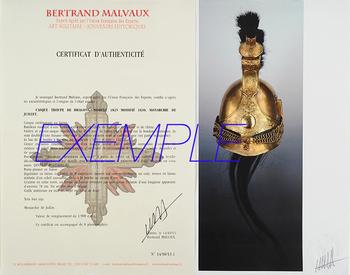
Next update Friday, december 26 at 13:30 PM
FOR ALL PURCHASES, PAYMENT IN MULTIPLE CHECKS POSSIBLE
bertrand.malvaux@wanadoo.fr 06 07 75 74 63
SHIPPING COSTS
Shipping costs are calculated only once per order for one or more items, all shipments are sent via registered mail, as this is the only way to have proof of dispatch and receipt.
For parcels whose value cannot be insured by the Post, shipments are entrusted to DHL or Fedex with real value insured, the service is of high quality but the cost is higher.
RETURN POLICY
Items can be returned within 8 days of receipt. They must be returned by registered mail at the sender's expense, in their original packaging, and in their original condition.
AUTHENTICITY
The selection of items offered on this site allows me to guarantee the authenticity of each piece described here, all items offered are guaranteed to be period and authentic, unless otherwise noted or restricted in the description.
An authenticity certificate of the item including the description published on the site, the period, the sale price, accompanied by one or more color photographs is automatically provided for any item priced over 130 euros. Below this price, each certificate is charged 5 euros.
Only items sold by me are subject to an authenticity certificate, I do not provide any expert reports for items sold by third parties (colleagues or collectors).
FOR ALL PURCHASES, PAYMENT IN MULTIPLE CHECKS POSSIBLE
bertrand.malvaux@wanadoo.fr 06 07 75 74 63
An authenticity certificate of the item including the description published on the site, the period, the sale price, accompanied by one or more color photographs is automatically provided for any item priced over 130 euros. Below this price, each certificate is charged 5 euros.
Only items sold by me are subject to an authenticity certificate, I do not provide any expert reports for items sold by third parties (colleagues or collectors).
